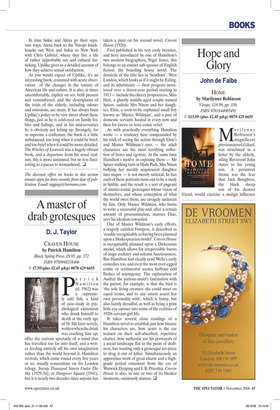A master of drab grotesques
D. J. Taylor
CRAVEN HOUSE by Patrick Hamilton Black Spring Press, £9.95, pp. 272 ISBN 9780948238406 V £7.95(plus £2.45 p&p) 0870 429 6655 Pa t r i c k Hamilton (d. 1962) was a supremely odd fish, a kind of case-study in psychological extremism who drank himself to death at the early age of 58. His later novels, written when the drink was cracking him up, offer the curious spectacle of a mind that has travelled too far into itself, and a writer feeding entirely off his own imagination rather than the world beyond it. Hamilton revivals, which come round every five years or so, usually concentrate on his London trilogy, Twenty Thousand Streets Under The Sky (1929-34), or Hangover Square (1941), but it is nearly two decades since anyone has taken a punt on his second novel, Craven House (1926).
First published in his very early twenties, and here introduced by one of Hamilton’s two modern biographers, Nigel Jones, this belongs to an extinct sub-species of English fiction: the boarding house novel. The domicile of the title lies in ‘Southam’, West London, which looks as if it might be Ealing, and its inhabitants — their progress monitored over a dozen-year period starting in 1913 — include the cheery proprietress, Miss Hatt, a ghastly middle-aged couple named Spicer, sadistic Mrs Nixon and her daughter, Elsie, a soon-to-be orphaned small boy known as ‘Master Wildman’, and a pair of domestic servants hauled in every now and then for (more or less) comic relief.
As with practically everything Hamilton wrote — a tendency here compounded by his trick of seeing the action through Elsie’s and Master Wildman’s eyes — the adult characters are the most terrifying collection of bores and egotists. At the same time Hamilton’s motive in exposing them — Mr Spicer stalking tarts in Hyde Park, Mrs Nixon bullying her meekly acquiescent daughter into stupor — is not merely satirical. In fact each of these portraits turns out to be a study in futility, and the result is a sort of pageant of sinister-comic grotesques whose vision of themselves, and whose conception of what the world owes them, are savagely undercut by fate. Only Master Wildman, who burns to write a successful play and, after a certain amount of procrastination, marries Elsie, sees his idealism rewarded.
One of Master Wildman’s early efforts, a tragedy entitled Vortigern, is described as ‘readily recognisable as having been planned upon a Shakespearian model’. Craven House is recognisably planned upon a Dickensian model, which allows for irrepressible bursts of stage cockney and solemn facetiousness. But Hamilton had clearly read Wells’s early comedies too, and even the most over-egged comic or sentimental scenes harbour odd flashes of astringency. The explanation of Audrey the parlour-maid’s fascination with the parrot, for example, is that the bird is ‘the sole living creature she could meet on equal terms, and to any extent assert her own personality with’, which is funny, but also faintly dreadful, as well as being a grim little eye-opener into some of the realities of 1920s servant-girl life.
It takes several close readings of a Hamilton novel to establish just how bizarre his characters are, how acute is the ear trained on their self-absorbed, repetitive chatter, how authentic are his portrayals of a social landscape flat to the point of drabness, but wanting only a grotesque set-piece to drag it out of kilter. Simultaneously an apprentice work of great charm and a highgrade period ornament from the era of Warwick Deeping and J. B. Priestley, Craven House is also, in one or two of its bleaker moments, ominously mature. ❑


































































































 Previous page
Previous page